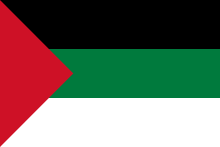Hejaz


Al-Hejaz, also, Hijaz (Arabic: الحجاز al-Ḥiǧāz, literally "the barrier") is a region in the west of present-day Saudi Arabia. It is bordered on the west by the Red Sea, on the north by Jordan, on the east by Nejd and on the south by Asir.[1] Its main city is Jeddah, but it is probably better known for the Islamic holy cities of Mecca and Medina. As the site of Islam's holy places, the Hejaz has significance in the Arab and Islamic historical and political landscape. The region is so called as it separates the land of Najd in the east from the land of Tihamah in the west.
It is also known as the "Western Province."[2]
Archaeology
One or possibly two megalithic dolmen have been found in Hejaz.[3]
History
Evidence suggests that the northern part of Hejaz was part of the Roman province of Arabia Petraea.[4]
The Hejaz includes both the Cradle of Gold at Mahd adh Dhahab (23°30′12.96″N 40°51′34.92″E / 23.5036000°N 40.8597000°E) and a potential water source now dried out that used to flow 600 miles (970 km) north east to the Persian Gulf via the Wadi Al-Batin system. Archaeological research led by of Boston University indicates that the river system, now prospectively known as the Kuwait River, was active 2500–3000 BC.[5]
Due to the presence of two holy cities in Hejaz, the region went under numerous empires throughout its modern history. Hijaz was later at the centre of the Caliphate, before its capital was moved to Damascus. The region was then under the control of regional powers such as Egypt and the Ottoman Empire through much of its later history, after which the Hejaz had a brief period of political independence in the early 20th century.
In 1916, Sharif Hussein ibn Ali proclaimed himself king of an independent Hejaz, as a result of the Hussein-McMahon Correspondence. The ensuing Arab Revolt overthrew the Ottoman Empire. In 1924, however, ibn Ali's authority was usurped by Ibn Saud of the neighboring region of Nejd, uniting it into what became known as the Kingdom of Hijaz and Nejd and later the Kingdom of Saudi Arabia.
-
.svg.png)
Flag of Rashidun Caliphate (632–661)
-

Flag of Umayyad Caliphate (661–750)
-

Flag of Abbasid Caliphate (750–1258)
-

Flag of Fatimid Caliphate (909–1171)
-

Flag of Ayyubid dynasty (1171–1254)
-

Flag of Mamluk Sultanate (1254–1517)
-

Flag of Ottoman Empire (1517–1916)
-

Flag of Kingdom of Hejaz (1916–1925)
-

Flag of Kingdom of Saudi Arabia (1925–present)
People of Hejaz
People of Hejaz, who feel particularly connected to the holy places of Mecca and Medina, have probably the most strongly articulated identity of any regional grouping in Saudi Arabia. Their place of origin alienates them from the Saudi state, which invokes different narratives of the history of the Arabian Peninsula. Thus, they experienced tensions with people of Najd.[6]
The people of Hejaz have never fully accommodated to Saudi and Wahhabi rule. Many consider themselves more cosmopolitan because Hejaz was for centuries a part of the great empires of Islam from the Umayyads to the Ottomans.[7]
This is compensated, however, by huge oil income, with all the oil found in the opposite end of Saudi Arabia.
Geography
The region is located along the Red Sea Rift. The region is also known for its darker, more volcanic sand. Depending on the previous definition, Hejaz includes the high mountains of Sarawat which topographically separate Najd from Tehamah. Bdellium plants are also abundant in the Hijaz.
Cities
See also
| Wikimedia Commons has media related to Hijaz. |
|
References
- Mackey, Sandra. The Saudis: Inside the Desert Kingdom. Updated Edition. Norton Paperback. W.W. Norton and Company, New York. 2002 (first edition: 1987). ISBN 0-393-32417-6 pbk.
Notes
- ↑ Merriam-Webster's Geographical Dictionary. 2001. p. 479. ISBN 0 87779 546 0. Retrieved 17 March 2013.
- ↑ Mackey, p. 101. "The Western Province, or the Hijaz[...]
- ↑ Gajus Scheltema (2008). Megalithic Jordan: an introduction and field guide. ACOR. ISBN 978-9957-8543-3-1. Retrieved 5 October 2012.
- ↑ Kesting, Piney (May/June 2001). "Well of Good Fortune". Saudi Aramco. Retrieved March 20, 2007.
- ↑ The Pishon River – Found. by C.A. Salabach at Focus Magazine
- ↑ Beranek, Ondrej (January 2009). "Divided We Survive: A Landscape of Fragmentation in Saudi Arabia". Middle East Brief 33: 1–7. Retrieved April 15, 2012.
- ↑ Riedel, Bruce (2011). "Brezhnev in the Hejaz". The National Interest 115. Retrieved April 23, 2012.
| ||||||||||||||||||||||||||||||||||||||||||||||||||
| ||||||||||||||||||||||||||||||||||

